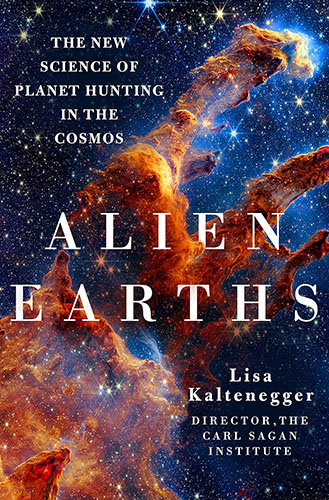Category: Nonfiction
Reviewed by: Peter Spasov
Title: Alien Earths: The New Science of Planet Hunting in the Cosmos
Author: Lisa Kaltenegger
Format: Hardcover, Kindle
Pages: 288
Publisher: St. Martin’s Press
Date: April 2024
Retail Price: $30.00/$14.99
ISBN: 978-1250283634
Find this book
In Alien Earths, Kaltenegger’s aim is to answer whether we are alone in the cosmos. Although the author does not reply with a definitive yes or no, she offers a multitude of maybes about how life could exist elsewhere. When we pursue our goal of becoming an interplanetary species, it is of interest to learn about these distant worlds which could potentially host human habitation, in addition to the numerous non Earth-like worlds. Readers can revel in the insights that Kaltenegger reveals.
With enthusiasm the author covers fundamentals regarding star systems, planets and characteristics of life. Hence the book is easily accessible to the general reader. Even for those more cognizant of space science, they can savor the passion Kaltenegger brings to the topic plus the flavorful way the author portrays newer discoveries. For instance, 51 Pegasi b is a Jupiter-like planet that circles its sun from a distance of ten times closer than Mercury is to our Sun. Furthermore, the planet circles its sun in a mere four and a half days, compared to Mercury, which requires three months. The author and her colleagues have personally analyzed data showing the planet’s atmosphere being ripped away by the star it orbits.
Her exuberance is infectious, such as the “scorching balls of gas and the heavens into a celestial history book of the cosmos.” In her explanations of astrophysics, she points out profound stats such as the Sun losing five million tons of mass each second, which she then equates to fifty thousand blue whales per second. Furthermore, due to the eventual demise of our Sun, she reminds us of what Carl Sagan wrote. “All civilizations become either spacefaring or extinct.”
Throughout the book the reader is immersed within the grandiosity of our cosmos and its ‘Great Silence,’ the fact that nobody has yet found advanced extraterrestrial life. There are speculative possibilities as to why this is so. The author discusses what makes a world habitable. Furthermore, how has our Earth caused life to evolve?
Due to the immense distance between us and the exoplanets, we can only check for the presence of life by using remote signatures. But what these could be is problematic. A spectral signal indicating oxygen in a planet’s atmosphere is not proof of life because intense radiation on a hot world would break water into oxygen and hydrogen. The author and other researchers have demonstrated this via simulations concentrating on the geochemical and thermal evolution of a planet’s mantle and crust and the interactions between the crust and atmosphere. Kaltenegger states, “That is why scientists are trained early to ruthlessly kill their darlings.”
And the elusive question is: What is life? The answer has no consensus. Kaltenegger attempts to answer, primarily in the context of terrestrial life. How extraterrestrials would see Earth depends on when they would be looking. Throughout its history, Earth has changed, ranging from volcanic to completely ice-bound. Thus, when we study the exoplanets, we only witness a snapshot of their histories.
Challenges abound: the immense remoteness of these alien worlds, how to recognize life and how to communicate with such life. Kaltnegger states that communication with other intelligence may be akin to talking to a jellyfish. The author reminds us some Earth-based life exists in environments hostile to us. Tardigrades have survived temperatures close to absolute zero, high radiation levels plus the vacuum of space. Recently, an Israeli lunar mission carrying tardigrades accidentally crashed on the Moon. To assess whether tardigrades could have survived the impact, scientists ran simulations by firing bullets containing them.
The final chapter is philosophical and introspective about the scale of the universe in both space and time and how our world is insignificant in comparison both physically and time wise. Kaltenegger asks who could be watching us. Only a tiny fraction of advanced extraterrestrials (if they exist) could have detected our radio signals.
Currently, the author is an Associate Professor of Astronomy at Cornell University and specializes in the atmospheres of extrasolar planets. She is a pioneer in revealing how Earth would look to aliens (if they exist) as Earth evolved over its four and a half billion years.
The book’s back matter consists of the Golden Record Playlist, the records carried by the Voyager spacecraft to portray life and culture on Earth to any extraterrestrials who may encounter them. There is also a Learn More section. My pre-publication copy suggests the final version will contain a complete index. Alien Earths is an inspirational resource for anyone interested in other worlds.
© 2024 Peter Spasov



















